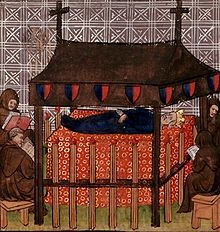
Philip IV, called Philip the Fair, was King of France from 1285 to 1314. By virtue of his marriage with Joan I of Navarre, he was also King of Navarre and Count of Champagne as Philip I from 1284 to 1305. Although Philip was known to be handsome, hence the epithet le Bel, his rigid, autocratic, imposing, and inflexible personality gained him other nicknames, such as the Iron King. His fierce opponent Bernard Saisset, bishop of Pamiers, said of him: "He is neither man nor beast. He is a statue."
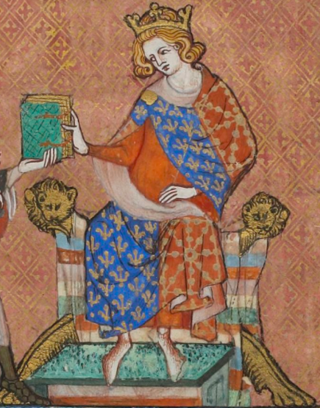
Louis X, known as the Quarrelsome, was King of France from 1314 and King of Navarre from 1305 until his death. He emancipated serfs who could buy their freedom and readmitted Jews into the kingdom. His short reign in France was marked by tensions with the nobility, due to fiscal and centralisation reforms initiated during the reign of his father by Grand Chamberlain Enguerrand de Marigny.

Philip III, called the Bold, was King of France from 1270 until his death in 1285. His father, Louis IX, died in Tunis during the Eighth Crusade. Philip, who was accompanying him, returned to France and was anointed king at Reims in 1271.

Charles III, called the Noble, was King of Navarre from 1387 to his death and Count of Évreux in France from 1387 to 1404, when he exchanged Évreux for the Duchy of Nemours.

The count of Champagne was the ruler of the County of Champagne from 950 to 1316. Champagne evolved from the County of Troyes in the late eleventh century and Hugh I was the first to officially use the title count of Champagne.
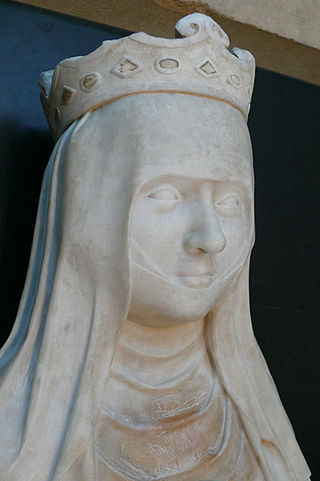
Joan of Évreux was Queen of France and Navarre as the third wife of King Charles IV of France.
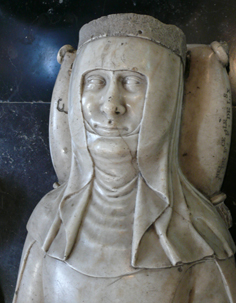
Joan II was Queen of Navarre from 1328 until her death in 1349.

Marie of Brabant was Queen of France from 1274 until 1285 as the second wife of King Philip III. Born in Leuven, Brabant, she was a daughter of Henry III, Duke of Brabant, and Adelaide of Burgundy.

Marie of Anjou was Queen of France as the spouse of King Charles VII from 1422 to 1461. She served as regent and presided over the council of state several times during the absence of the king.

Blanche of Artois was Queen of Navarre and Countess of Champagne and Brie during her marriage to Henry I of Navarre. After his death she became regent in the name of their infant daughter, Joan I. She passed on the regency of Navarre to Philip III of France, her cousin and her daughter's prospective father-in-law, but retained the administration of Champagne. She later shared the government of Champagne with her second husband, Edmund, until her daughter reached the age of majority.

Philip III, called the Noble or the Wise, was King of Navarre with his wife Joan II from 1328 until his death in 1343. He was also Count of Évreux in France from 1319.

The County of Champagne, was a medieval territory and feudal principality in the Kingdom of France. It developed on the rich plains between Paris and the border of the Holy Roman Empire in the 12th century. It became an economic hub of northern France and an international trade center in part due to the trade fairs instituted by Count Theobald II, and steady land clearing led to economic and urban growth. Count Henry the Liberal established the city of Troyes as the county's capital and expanded the state. The court of Champagne under Count Henry and Countess Marie saw a proliferation of literary authors. In the 13th century, Count Theobald III, Countess Blanche, and Count Theobald IV oversaw a centralization of the state. The county is noted for its support to the crusades and monastic foundations, especially those of the Cistercians, which originated within its borders. From 1234 the count of Champagne was also the king of Navarre, and the marriage of Queen Joan I of Navarre with King Philip IV of France led to the county being absorbed into the royal domain of the kings of France in the 14th century.
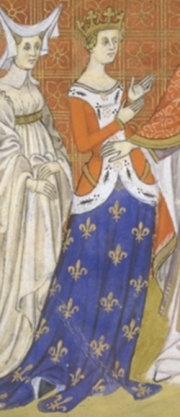
Blanche of Burgundy was Queen of France and Navarre for a few months in 1322 through her marriage to King Charles IV the Fair. The daughter of Count Otto IV of Burgundy and Countess Mahaut of Artois, she was led to a disastrous marriage by her mother's ambition. Eight years before her husband's accession to the thrones, Blanche was arrested and found guilty of adultery with a Norman knight. Her sister-in-law, Margaret of Burgundy, suffered the same fate, while her sister Joan was acquitted. Blanche was imprisoned and not released even after becoming queen, until her marriage was annulled when she was moved to the coast of Normandy. The date and place of her death are unknown; the mere fact that she died was simply mentioned on the occasion of her husband's third marriage in April 1326.

Joan II, Countess of Burgundy, was Queen of France by marriage to Philip V of France; she was also ruling Countess of Burgundy from 1303 to 1330 and ruling Countess of Artois in 1329–1330.
Isabella of Navarre was the younger surviving daughter of Charles III of Navarre and his wife Eleanor of Castile. She was a member of the House of Évreux.
Joan of Navarre was the heiress presumptive to the throne of Navarre in 1402–1413, and regent of Navarre in the absence of her father in 1409–1411.
Blanche of France, nun at Longchamp Abbey, was the fourth and youngest daughter of King Philip V of France and Countess Joan II of Burgundy.

The Treaty of Orléans was a marriage treaty signed in 1275, that led to a short-lived personal union between the kingdoms of Navarre and France. It was signed by Philip III of France and his cousin Blanche of Artois, mother and regent to the two-year-old Joan I of Navarre. The original intent of the treaty was to not create a personal union, however, but to enable Philip to administer Navarre in Joan's name. Joan was also to marry either Philip's firstborn and heir apparent, Louis, or his second son, Philip. Pope Gregory X explicitly stated that he preferred a match with the younger son, as he probably wished to avoid merging Navarre with France. Louis died in 1276, however, leaving Philip as the only choice per the terms of the treaty.
Joan of Navarre was a princess from the French House of Évreux, the eldest child of King Philip III and Queen Joan II of Navarre.
Events from the year 1305 in France

